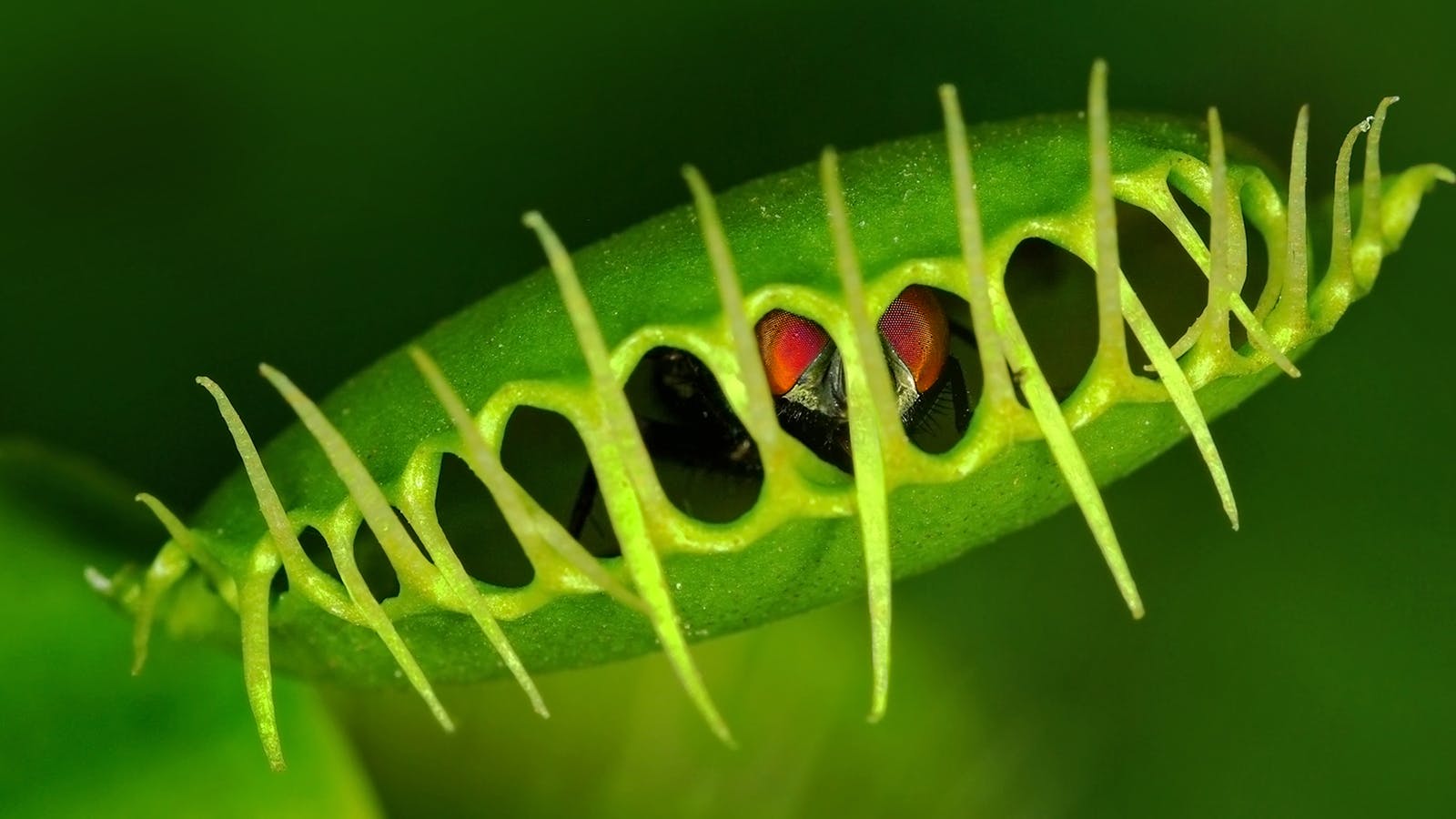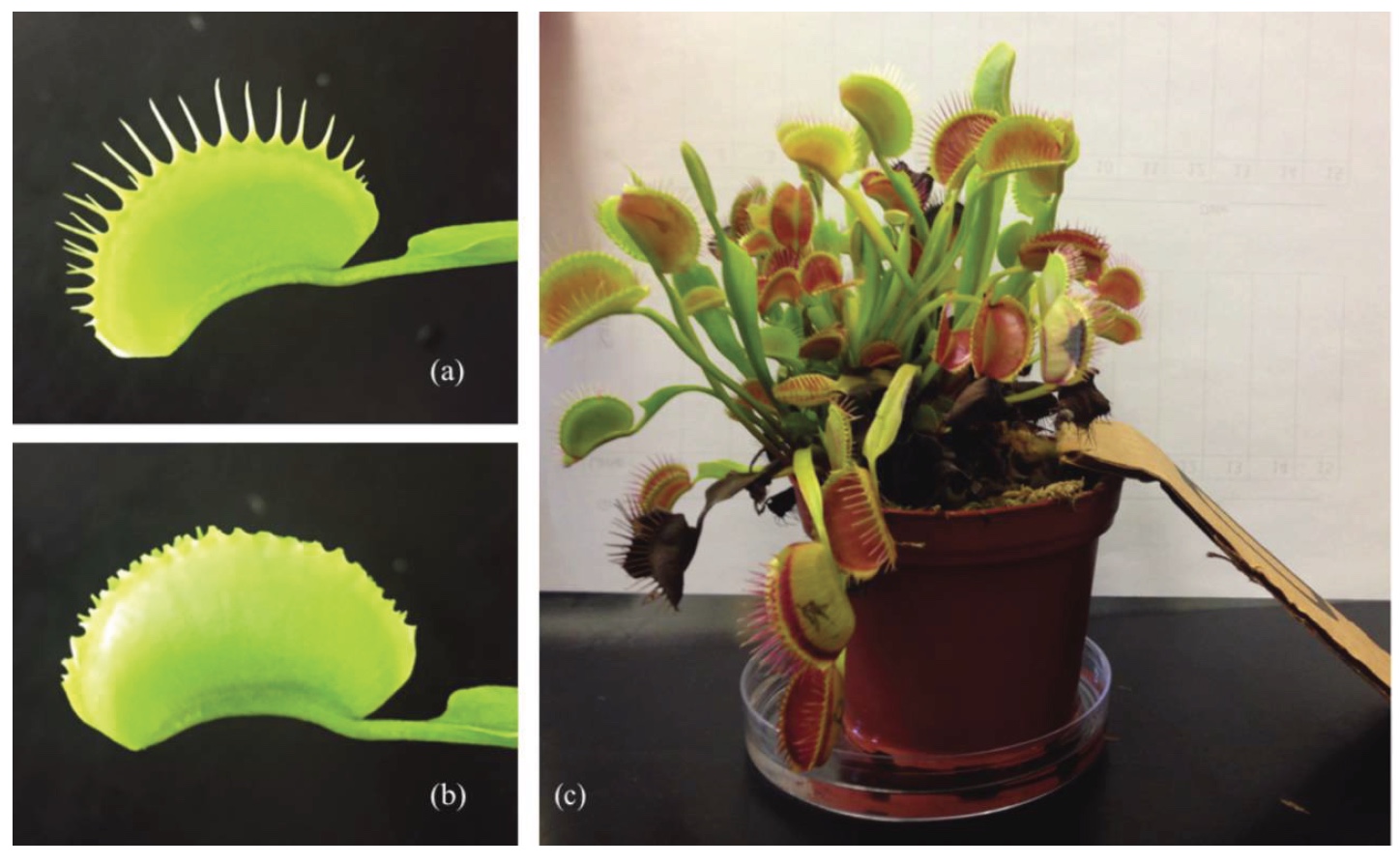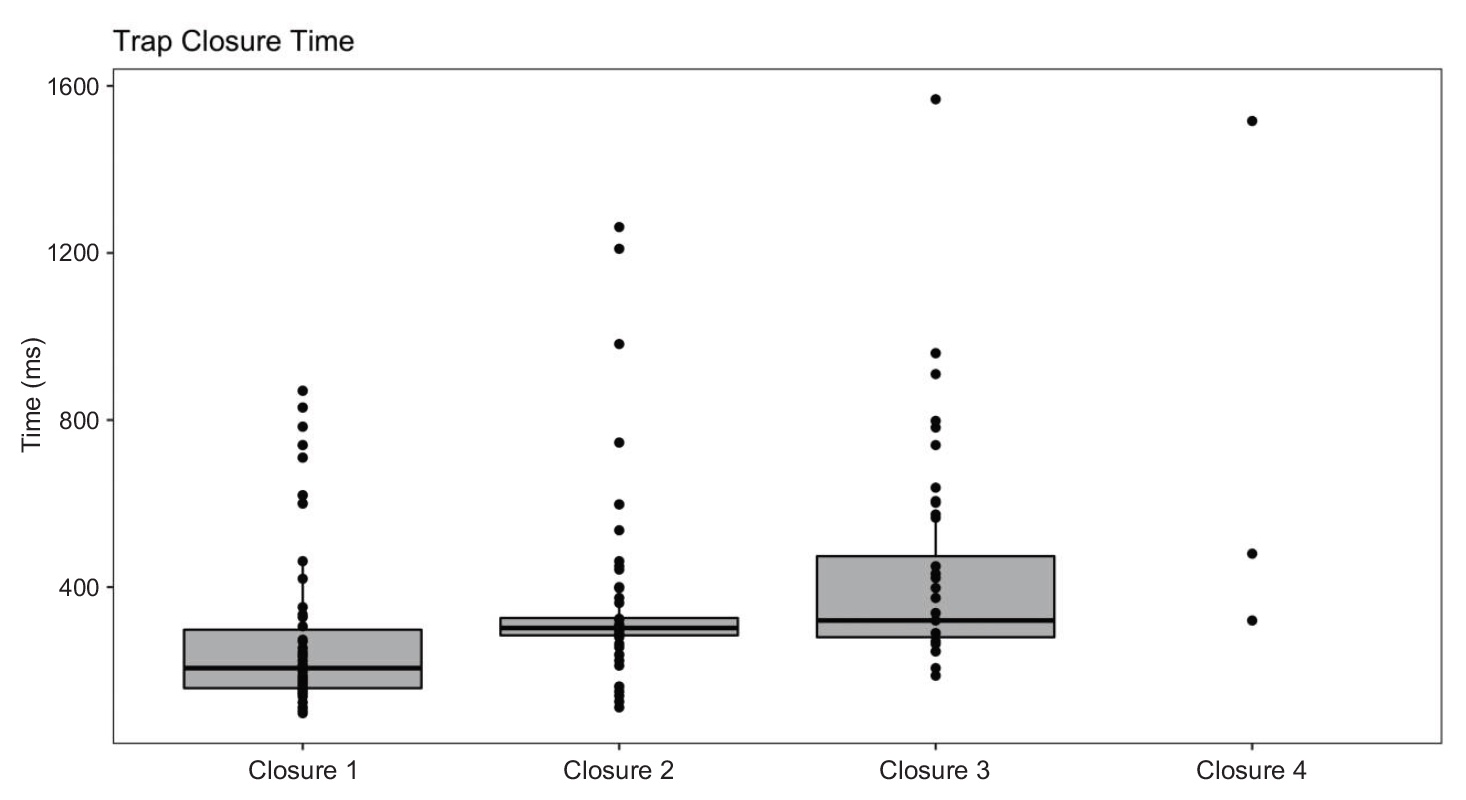Terrible Prison: A Study of the Marginal Spikes of a Venus Flytrap

Friday is a beautiful day when gray everyday life is coming to an end (forgive me for pouring salt on the wound for those who work on Saturday / Sunday), the long-awaited weekend awaits us, and we have time to do something pleasant and interesting: read a book that has already collected a record layer of dust; visit relatives if they still remember you; to sleep, waking up in the morning not from a terrible alarm clock, but in a natural way; water a flower in a pot, which will soon evolve into a cactus, tumbleweed or carnivorous monster, as in the movie "Little Shop of Horrors." In this film, the killer plant is a fictional creation, but it has an ancestor in the real world - predatory plants, specifically, the venus flytrap. This plant is Jason Voorhees in the insect world. And as for Jason the machete is characteristic, so for the flycatcher its marginal (marginal) spines are characteristic. Today we will meet with you a study in which scientists decided to check how important these spikes are in catching prey. Naturally, they are important - you say, and you are right, but the results of the study were not without surprises. We will not pull the mosquito by the proboscis and plunge into the report for clarification. Go.
Awful Prison
We all know the concept of photosynthesis, which refers to the chemical process of converting light energy into energy of chemical compounds. However, not all plants like the solar diet, or rather, not everyone can feed themselves exclusively in this way due to certain climatic conditions and the place of growth. If you want to live, be able to spin, in this case, evolve into the nightmare of all flies. In other words, carnivorous plants, in addition to the “classical” diet, get the necessary substances (for example, nitrogen) by digesting insects (or other creatures that are unlucky). In total, there are about 630 species of predatory plants that grow in almost all regions of the planet and differ both in the method of hunting and in gastronomic preferences.
According to the type of fishing, prey plants can be divided into two main types: active and passive. The former possess moving parts (like our current heroine, the flycatcher), and the latter possess sticky secretions on the surface of leaves or containers where the victim falls down on its own.

Giant biblis
The largest representatives of predatory plants are the giant biblis and nepentes. The giant biblis resembles an ordinary shrub with very beautiful flowers, but this plant is very insidious - all of its leaves and stems are covered with small hairs (approximately 300,000 pieces on 1 sheet) and glands that secrete juice. This nectar attracts a victim who, having longed for free food, becomes herself, tightly sticking to the hairs. At the same time, the juice secreted by the plant is not just a bait, but also a digestion tool. The biblical victims can be insects and snails, as well as small amphibians or very unsuccessfully landed birds.
The symbiotic relationship of Nepentes and a spider using the plant’s reservoir as a place for “fishing”.
The second name of Nepentes is the pitcher, which directly speaks of the method of catching prey. Nepentes has two types of leaves: ordinary and unusual, which form a jug hanging in the air filled with nectar. The edges of this jug are also covered with nectar, therefore the insect attracted by its smell sits and rolls in, where it is digested by the plant. But Nepentes is different from other predator plants, he is not only a serial killer, but also a good friend if you are dumb. This small animal feeds on the nectar of the plant and uses its jug trap as a night pot. The waste products are digested and give the plant the necessary nutrients.

Even in the flowering of a flytrap, there is logic: the flowers bloom on a long stalk away from traps in order to protect pollinating insects from an industrial accident.
And finally, active predators. The most famous among them is the flycatcher. Its leaves at the end of a thin stalk resemble a trap or an open, hungry and very toothy mouth. Inside the trap is covered with thin and very sensitive hairs, hitting which the victim activates the closing of the trap. But such an activation method is not the most effective, you think. And if the wind blew or it started to rain, and the hair was touched by accident? But don’t worry, for this flytrap trap perfected the mechanism for many years of evolution. For the shutters to close, it is necessary to touch at least 2 hairs with an interval of no more than 20 seconds. In this case, the process of digestion, which takes place inside the trap, will begin only after repeated stimulation of the sensitive hairs. Thus, the flycatcher will not start the process of digesting, for example, a fallen leaf,
The mechanism of trap collapse in flytraps is based on chemical and cellular processes. The most important role is played by tissue turgor, that is, the stress state of the shells of living cells. When the victim stimulates sensitive hairs, an action potential is generated due to potassium ions, which spreads along the leaf lobes and stimulates the cells. When the trap is open, its lobes are bent outward (so it will be easier for the victim to fall into the trap), and when the trap closes, the lobes bend in the opposite direction. Thus, the inner space is formed. The living victim will not stand still, but will constantly move, trying to get out. But here, as in a swamp - the more you move, the faster you will drown. Constant movement of the victim stimulates the hairs, which leads to the release of the digestive enzyme.
An important aspect of the operation of traps is their fragility and deformation. Slamming the sheet shares into the blank leads to the fact that in subsequent times the trap will close more slowly and the angle of the open state will be much smaller. As we understand, such changes can greatly affect the capture of prey, and therefore lead to the death of the plant due to hunger. In addition, after several closures, the traps die off quickly enough.
True Facts: Carnivorous Plants. The video contains a lot of black humor and some obscene language.
An important role in catching prey for flycatchers is played by edge spikes that prevent the victim from escaping from the stomach trap. However, as with sensitive hairs, these spikes are not so simple.
The study in question is based on the hypotheses of Charles Darwin, who was the first to describe the hunting mechanism of a venus flytrap, calling its trap “a terrible prison.” He suggested that the spikes are important not only for keeping the prey, but also as a peculiar method of “filtering” it. In other words, too small a prey, the nutritional benefits of which will not be enough, can get out between the spikes, and too large a prey will simply reveal the fractions of the leaf and also run away. In both the first and second cases, the energy consumption of a flycatcher for such types of prey would not be comparable with the resulting energy from their digestion. Accordingly, the spikes of a flytrap allow it to catch prey of a certain size. However, despite the fact that more than 100 years have passed since the discoveries of Darwin, no one tested his hypotheses in practice.
Such attention from scientists, Venus flytrap, did not yet know. Researchers measured prey capture efficiency, trap closure times, and the influence of edge spikes both in the wild and in the laboratory. Also, scientists tested the efficiency of the trap without spikes, having previously removed them.
Research results
Observations of plants were carried out in the wild (Green marshes in North Carolina, USA), in laboratory and in hybrid conditions. Green marshes are one of the few areas where endemic species of flycatchers can still be found. Scientists identified 14 individual plants, whose traps they divided into 4 categories: living and closed, dead and closed, living and open, dead and open. A total of 100 traps were counted. With the help of scanning, it was established that something (prey or garbage) was inside the closed traps: traps with something designated "1", empty ones - "0".
Among the closed traps of wild flycatchers, only 24% contained prey. It was precisely succeeded to establish that in 8 traps out of 98 there was garbage, and 2 clearly contained insects (an ant in one and a spider in the second). 55 ± 5% of traps were open and capable of catching prey (live, intact leaves). The percentage of closed traps with prey inside varied from 0 to 50% depending on the individual plant under consideration. In 5 plants, this indicator was 0%, in five more - from 0 to 33%, and in four more - 34-50%.
The laboratory experiment involved grown plants and purchased crickets, which in the wild occupy about 10% of the flycatcher’s diet. All insects participating in the tests were healthy, with all six legs in place. Their length ranged from 7 to 23 mm, and weight - from 0.026 to 0.420 grams. In the laboratory test, all traps were labeled in the same way as in observations in the wild: closed but empty - “0”, closed and with prey inside - “1”. Trap testing took place 3 days and 1 week after the start of the test.

Image No. 1: a - trap with edge spikes, b - trap without spikes, c - laboratory experiment (1 plant in a container of water, 1 cricket and gangway to make it easier for an insect to get to the plant).
After the first approach, the scientists removed the edge spikes from the closed traps ( 1b ). After this, the plant was given 1 week to restore and open the trap.
After the traps re-opened (already without spikes), the second testing stage was carried out using a new cricket. A total of 51 test runs were conducted with 34 plants: 17 plants - observations without manipulation by humans and another 17 - observations before and after removal of thorns. There were also two types of control approaches: 5 with dead cricket and 2 without an insect at all. Thus, it was possible to verify that the closure of traps occurs solely due to live crickets, and not in random order.
Among the plant traps that were not manipulated, only 16.5% successfully caught the insect. The spike-cut traps recovered after 4 days, but only 5.8% of them were able to catch prey. However, the procedure for removing thorns, that is, physical damage to plant tissues, did not have a negative effect. So, the closing speed, plant growth and general condition did not differ in pristine plants and plants with removed thorns. In addition, after 1 week, the spikes began to regrow.
The likelihood of a successful hunt with removed spikes decreased by 90% compared to pristine traps.

Image No. 2: results of hunting flycatchers in the wild (upper graph), in the laboratory (second and third graph) and in a hybrid experiment (lower graph).
However, observational data already indicate that with large production sizes, the benefits of having spikes are greatly reduced. A linear model with mixed effects showed that the weight of the prey is the determining factor in the success of the hunt. So, with an increase in insect weight of only 0.1 g, the likelihood of successful capture is reduced by 73%.
Naturally, the dimensions of the traps themselves are also very important. With an increase in the length of the trap by 1 cm, the chance of a tasty meal for the plant increases 2.9 times. In this case, the presence or absence of marginal spikes does not matter.

Image No. 3: the success of hunting intact plants (left) and plants with removed thorns (right). Z axis - probability of capture of prey (blue-red color variation from minimum to maximum) depending on the weight of the prey (X axis) and trap length (Y axis).
As we can see in the graph above, the probability of a successful capture from a trap without spikes (the graph on the right) is small enough when the production weight and length of the trap are also small. But with greater weight and greater length, this indicator is comparable to plants whose thorns remained in place.
The hybrid experiment was a change of location from the laboratory to the North Carolina Botanical Garden, where 22 flycatchers were planted. Each plant had 50/50 pristine and thornless traps (removal was carried out in the laboratory before planting in the garden, after which the plant was restored and the traps opened). The observations lasted 4 weeks, scientists recorded all the data: the size of the caught prey or garbage that fell into the trap, the size of closed traps, the frequency of closing / opening, etc.
Plants in the botanical forest showed not very high results in successful capture of prey: 13.3% in pristine traps and 9.2% in traps without spikes. However, these results are very similar to those that scientists observed under controlled laboratory conditions. Moreover, as can be seen from the graph in image 2, the greatest probability of success was observed precisely in the case of medium-sized production.

Image No. 4: time required for 1st, 2nd, 3rd and 4th trap closure.
Scientists also measured the rate of trap closure during the first, second, and third approaches. During the first closure, the speed was approximately 283 ± 29 ms, during the second - 383 ± 43 ms and during the third - 528 ± 62 ms. Those few traps that survived to the fourth closure showed a significant decrease in speed to 772 ± 374 ms. As we already know, traps of flytraps cannot be closed / opened infinitely many times. During the study, only 38 of the 50 traps survived after the second closure, 25 of 38 - after the third, and only 4 traps survived until the end of the 4 week hybrid experiment.
For a more detailed acquaintance with the study, I recommend that you look into the report of scientists .
Epilogue
Scientists note that the importance of marginal spikes in traps is not as great as it seemed before. Especially when it comes to large traps and / or large prey. Observations showed that crickets very often climb precisely on the spikes of the trap (not inside the trap). When the trap closes, the cricket can put pressure on the spikes and easily get out. If there are no thorns on a large trap, then there is nothing to press on, therefore the cricket remains in a trap. It turns out that the spikes serve as an escape tool for large insects.
With small prey, everything is clear: if it provokes the closure of the trap, it will get out through the openings between the spikes. Thus, the trap will open again without spending energy on digesting malnutrition food. In the case of large prey, it may seem that the flycatchers will be only too happy to feast on someone large and juicy. I caught a big tarantula and digest myself calmly, without thinking about the search for food, so to speak. However, in practice, everything looks different - a large prey uses spikes to get out. Scientists, in turn, will continue to research in order to fully understand whether this is a drawback for flytraps or is it still a well-thought-out evolutionary mechanism that ensures the catch of certain sizes.
Be that as it may, this study allowed us to look at the life of predatory plants under the prism of mathematical measurements and calculations, and also to understand that not all evolutionary devices have an obvious purpose. The world of flora and fauna is full of secrets and mysteries that we still have to solve.
And, of course, Friday's off-top:
A small movie from the movie "Little Shop of Horrors" (1986). In the role of Seymour Rick Moranis, the voice of a carnivorous extraterrestrial plant is Levy Stubbs.
Thanks for watching, stay curious and have a great weekend everyone, guys.
A small movie from the movie "Little Shop of Horrors" (1986). In the role of Seymour Rick Moranis, the voice of a carnivorous extraterrestrial plant is Levy Stubbs.
Thanks for watching, stay curious and have a great weekend everyone, guys.
Thank you for staying with us. Do you like our articles? Want to see more interesting materials? Support us by placing an order or recommending it to your friends, a 30% discount for Habr users on a unique analogue of entry-level servers that we invented for you: The whole truth about VPS (KVM) E5-2650 v4 (6 Cores) 10GB DDR4 240GB SSD 1Gbps from $ 20 or how to divide the server? (options are available with RAID1 and RAID10, up to 24 cores and up to 40GB DDR4).
VPS (KVM) E5-2650 v4 (6 Cores) 10GB DDR4 240GB SSD 1Gbps until the summer for free when paying for a period of six months, you can order here .
Dell R730xd 2 times cheaper? Only we have 2 x Intel Dodeca-Core Xeon E5-2650v4 128GB DDR4 6x480GB SSD 1Gbps 100 TV from $ 249in the Netherlands and the USA! Read about How to Build Infrastructure Bldg. class using Dell R730xd E5-2650 v4 servers costing 9,000 euros for a penny?
